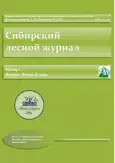THE INFLUENCE OF FEEDING AREAS ON THE FALL OF TREES IN PINE CROPS
- 作者: Rogozin M.V.1
-
隶属关系:
- Perm State National Research University
- 期: 编号 1 (2024)
- 页面: 57-66
- 栏目: RESEARCH ARTICLES
- URL: https://bakhtiniada.ru/2311-1410/article/view/297592
- DOI: https://doi.org/10.15372/SJFS20240107
- ID: 297592
如何引用文章
全文:
详细
55-year-old crops of Scots pine ( Pinus sylvestris L.) the IB productivity class (bonitet) with a completeness of 0.94 on an area of 1.9 hectares, created according to the scheme 1.82 × 1.10 m, were studied. More than 2 thousand trees were located on this area and polygons of their nutrition were built around them in the «ArcMap-ArcView» program. The territory was divided into 24 test areas, with density fluctuations at the age of 30 years 1153-2207 trees/ha, a fullness of 0.84-1.03 and an average diameter of 19.1-23.0 cm. It was found that the density affects the intensity of the fall of trees by only 22 %, and 78 % of the factors of their fall are not related to the density. Therefore, increased density within these limits is not the main reason for the fall of trees. It was also found out that in the younger class of the tree’s feeding area, the probability of its falling off after 25 years is the greatest (58 %) and gradually decreases to 5-7 % by the senior classes. At the same time, the area of nutrition increased by 2.1 times or more did not guarantee the trees their complete safety by the age of 55, and in 9.6 % of cases they died for no apparent reason. The feeding areas of falling trees turned out to be almost functionally related to the frequencies of feeding areas at the age of 30 with a correlation of R = 0.95 ± 0.03, and this leads to the fact that their small feeding area (less than average) increases the probability of falling off by only 27 %. This is confirmed by S. N. Sennov’s research (1999, 2005) that despite intensive thinning at the age of 40, over the next 40 years trees died at any diameter, and the nature of the fall did not differ from the control. Therefore, from a forestry point of view, thinning felling in middle age is no longer effective. We need a much earlier optimization of the density of the stand at the age of 10-15 years.
作者简介
M. Rogozin
Perm State National Research University
编辑信件的主要联系方式.
Email: rog-mikhail@yandex.ru
Perm, Russian Federation
参考
- Баландин Р. К. Анти-Дарвин. Миражи эволюции. М.: Яуза Эксмо, 2010. 350 с
- Голиков А. М. Эколого-диссимметрический и изоферментный анализ структуры модельных популяций сосны обыкновенной // Лесоведение. 2011. № 5. С. 46-53
- Гриффитс Дж. Научные методы исследования осадочных пород. Пер. с англ. М.: Мир, 1971. 422 с
- Демаков Ю. П. Структура и закономерности развития лесов Республики Марий Эл. Йошкар-Ола: Поволж. гос. технол. ун-т, 2018. 432 с
- Колтунова А. И. О формировании горизонтальной структуры и срастании корневых систем в древостоях сосны // Экопотенциал. 2013. № 3-4. С. 136-142
- Марченко И. С. Биополе лесных экосистем. Брянск: Товарищество «Придесенье», 1995. 188 с
- Маслаков Е. Л. Генезис и динамика социальных структур сосны в фазе индивидуального роста // Таежные леса на пороге XXI века. СПб.: СПбНИИЛХ, 1999. С. 42-51
- Морозов Г. Ф. Учение о лесе. Изд. 7-е. М., Л.: Гослесбумиздат, 1949. 453 с
- Плантационное лесоводство / Под ред. И. В. Шутова. СПб.: Изд-во Политех. ун-та, 2007. 366 с
- Правила ухода за лесами. Приказ Министерства природных ресурсов и экологии Российской Федерации от 30.07.2020 № 534. М.: Минприроды России, 2020
- Разин Г. С. Динамика сомкнутости одноярусных древостоев // Лесоведение. 1979. № 1. С. 23-25
- Рогозин М. В. Структура древостоев: конкуренция или партнерство? Пермь: ПГНИУ, 2019. 223 с
- Рогозин М. В., Михалев В. В., Рыбальченко А. Я. Лесные экосистемы и факторы неотектоники. Пермь: ПГНИУ, 2020. 249 с
- Русинова Н. В., Варсегова Л. Ю. Оценка качества рубки ухода по изменению площадей произрастания деревьев в биогруппе // Лесн. хоз-во. 2009. № 1. С. 29-30
- Терехов Г. Г., Усольцев В. А. Морфоструктура насаждений и корненасыщенность ризосферы культур ели сибирской и вторичного лиственного древостоя на Среднем Урале как характеристика их конкурентных отношений // Хвойные бореал. зоны. 2010. Т. 27. № 3-4. С. 1-7
- Тихонова И. В. Четыре опоры к фундаменту современного устойчивого лесоводства // Лесные экосистемы: современные вызовы, состояние, продуктивность и устойчивость: Материалы междунар. науч.-практ. конф., посвящ. 90-летию Ин-та леса НАН Беларуси, Гомель, 13-15 ноября 2020 г. Гомель: Ин-т леса НАН Беларуси, 2020. С. 97-101
- Усольцев В. А., Часовских В. П., Акчурина Г. А., Осмирко А. А., Кох Е. В. Фитомасса деревьев в конкурентных условиях: исследование системных связей средствами информационных технологий. Екатеринбург: УГЛТУ, 2018. 526 с
- Хильми Г. Ф. Теоретическая биогеофизика леса. М.: Наука, 1957. 205 с
- Erfanifard Y., Stereńczak K.Intraand interspecific interactions of Scots pine and European beech in mixed secondary forests // Acta Oecol. 2017. V. 78. Р. 15-25
- Grubb P. J. Root competition in soils of different fertility: a paradox resolved? // Phytocoenologia. 1994. V. 24. N. 1-4. P. 495-505
- Kadmon R. Plant competition along soil moisture gradients: A field experiment with the desert annual Stipa capensis //j. Ecol. 1995. V. 83. N. 2. P. 253-262
补充文件









